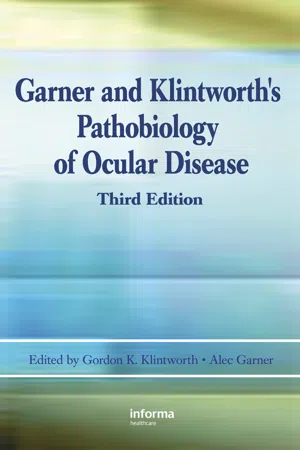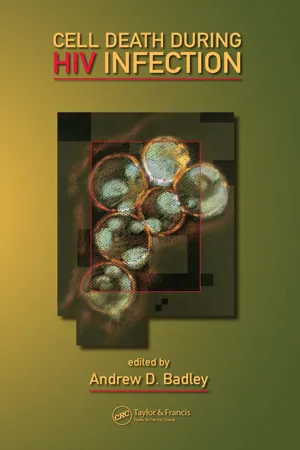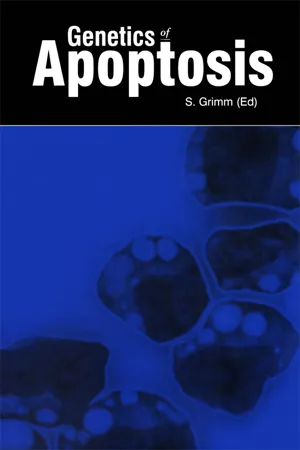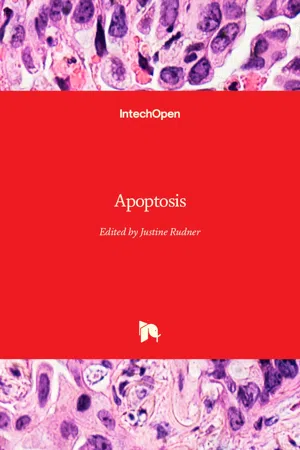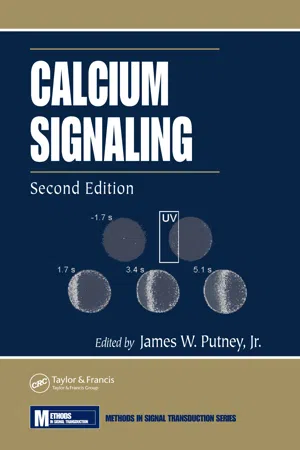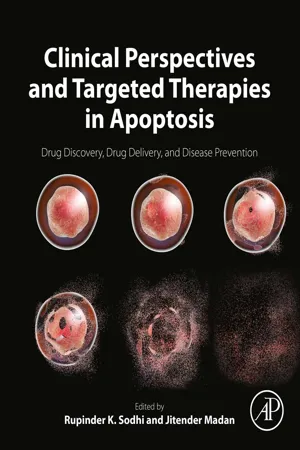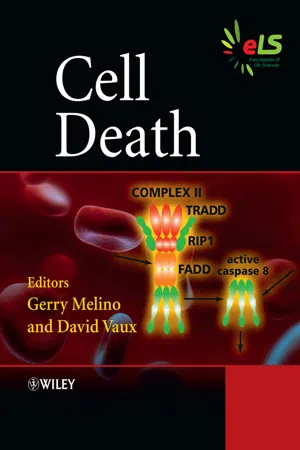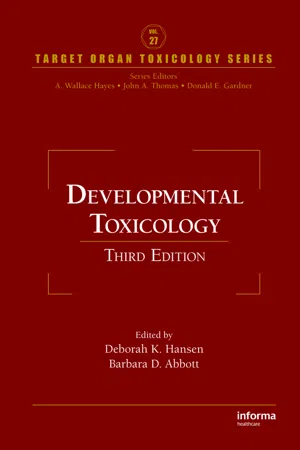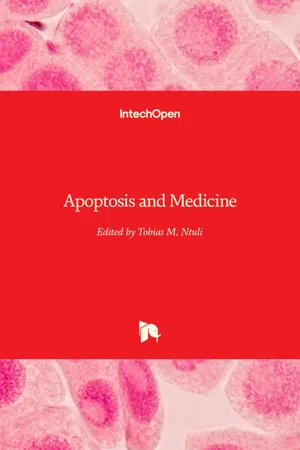Biological Sciences
Apoptosis
Apoptosis is a programmed cell death process that occurs in multicellular organisms. It plays a crucial role in maintaining tissue homeostasis by eliminating unwanted or damaged cells. Apoptosis is characterized by distinct morphological and biochemical changes in the cell, ultimately leading to its controlled self-destruction.
Written by Perlego with AI-assistance
Related key terms
1 of 5
12 Key excerpts on "Apoptosis"
- Gordon K. Klintworth, Alec Garner, Gordon K. Klintworth, Alec Garner(Authors)
- 2008(Publication Date)
- CRC Press(Publisher)
2 Apoptosis Victor M. Elner, Hakan Demirci, and Susan G. Elner Kellogg Eye Institute, University of Michigan, Ann Arbor, Michigan, U.S.A. n INTRODUCTION 29 n HISTORY OF THE CONCEPT OF Apoptosis 30 n EXTRINSIC APOPTOTIC PATHWAY 30 n Fas and TRAIL Receptor Pathway 32 n TNF Receptor Pathway 33 n THE INTRINSIC APOPTOTIC PATHWAY 33 n CONVERGENCE OF APOPTOTIC PATHWAYS 36 n THE FINAL APOPTOTIC PATHWAY: CASPASES 37 n Inhibitors of Apoptosis 38 n ENDOPLASMIC RETICULUM AND Apoptosis 38 n REGULATORY MECHANISMS 38 n Myc Pathway 38 n NF k B Pathway 39 n JNK Pathway 39 n AKT Pathway 39 n REMOVAL OF APOPTOTIC CELLS 40 n Apoptosis IN DISEASE 40 n REFERENCES 42 INTRODUCTION Cell death is an important process that regulates dynamic balances in living systems during develop-ment, growth, homeostasis, disease, and repair (see Chapter 1) (48). Three types of cell death are known: ( i ) Apoptosis (programmed cell death), ( ii ) autophagy, and ( iii ) necrosis (69). Apoptosis is a highly regulated mechanism by which cells die in response to defined internal or external stimuli. Autophagy is character-ized by bulk degradation of cellular components, principally proteins that are essential for maintaining cellular integrity when nutrients are scarce. Necrosis is a passive process characterized by disruption of cell membranes and a progressive breakdown of orga-nelles in response to severe environmental perturba-tions such as hypoxia/ischemia, temperature variations, and mechanical trauma. The morphologic differences between these different types of cell death are presented in Table 1. In this chapter, we will focus on Apoptosis. Apoptosis is a major control mechanism by which cells undergo self-destruction. Whatever its initiating stimulus, the end target of Apoptosis is irreparable DNA damage.- eBook - PDF
- Andrew D. Badley(Author)
- 2005(Publication Date)
- CRC Press(Publisher)
Alterations in this balance inevitably lead to loss of tissue homeostasis and the onset of several diseases. More than 30 years ago, Kerr and coworkers described a novel form of cell death with peculiar morphological characteristics, and its crucial role in cellular biology became clear in the following years. 1 They named this type of cell death “Apoptosis.” Apoptosis is a highly organized and genetically controlled type of cell death, which has proven to be essential during embryonic development to ensure proper organogenesis. 2 It is characterized by a number of sequential mor- phological alterations, such as chromatin condensation, cell shrinkage, plasma membrane alterations with surface blebbing, and, in the latest stages, fragmentation of the cell into membrane-bound vesicles containing intact organelles called apoptotic bodies. 3 Removal of the apoptotic bodies is achieved via phagocytosis by neighboring cells and professional phagocytes such as macrophages. The prompt clearance of dying cells before the onset of secondary necrosis and lysis of the apoptotic bodies supposedly prevents the triggering of the immune response. Apoptosis is also crucial in adult organisms, as it enables the elimination of unwanted aged, harmful, or infected cells to maintain normal cellular homeostasis and preserve tissue functions. Insufficient Apoptosis can result in development of cancer or autoimmunity, whereas excessive cell death has been linked to acute injuries (such as stroke; myocardial infarct; fulminant hepatitis; reperfusion damage), chronic degenerative diseases (including multiple sclerosis, amyotropic lateral sclerosis, Alzheimer’s disease, Parkinson’s disease, and Huntington’s disease), immunodeficiency (including acquired immunodeficiency syndrome [AIDS]); and infertility. - eBook - PDF
Animal Cell Technology
Products of Today, Prospects for Tomorrow
- R. E. Spier, J. B. Griffiths, W. Berthold(Authors)
- 2013(Publication Date)
- Butterworth-Heinemann(Publisher)
Section 7 Apoptosis and Cell Biology This page intentionally left blank Programmed to Die : Cell Death via Apoptosis Thomas G. Cotter Cell Biology Laboratory, Dept. of Biology, St. Patrick's College, Maynooth, Co. Kildare, Ireland. Key Words : Apoptosis, Cell death, Endonuclease, Oncogene Programmed cell death or Apoptosis is the mechanism by which cells die under largely physiological conditions. During this process the cell's DNA is fragmented into nucleosome size units, due to the activation of an endogenous nuclear endonuclease. Water is extruded from the cell and there is a marked decrease in cell size and increase in density. The shrunken apoptotic cells subsequently fragment into sealed vesicles called apoptotic bodies. A variety of agents, including toxins, drugs, environmental factors, etc induce cell death via Apoptosis. Apoptosis is genetically controlled and regulatory roles have been identified for the oncogenes c-myc, bcl-2 and the tumour suppressor gene p53. Introduction Mitosis the ubiquitous mechanism by which cells in multicellular organisms replicate themselves, is a fairly well understood process at the genetic and biochemical levels. Cells go though different phases of the cell cycle duplicating virtually every protein, lipid and organelle, until they finally undergo cell division by mitosis. During this process chromosomes containing the genetic blue print for cell life are neatly parcelled out to daughter cells and the cell cycle begins again. Thus, where there was once one cell, now there are two and as cells continually move though the cell cycle their numbers increase and multiply. However, in adult multicellular organisms like ourselves, wherein there is considerable cell proliferation via mitosis, there is little or no increase in total body cell numbers. This reason for this is that for every new cell that comes into being by mitosis one old one dies. - Gordon K. Klintworth, Alec Garner, Gordon K. Klintworth, Alec Garner(Authors)
- 2007(Publication Date)
- CRC Press(Publisher)
The term “Apoptosis” was coined, originating from the combi-nation of the Greek words “apo,” meaning separation, and “ptosis,” meaning falling off, as it pertains to the seasonal shedding of leaves from trees or of petals from flowers (30,37). When co-opted for its use in medical biology, Apoptosis is used to signify this process of programmed cell death (37). Later, apopto-tic programmed cell death was shown to be an active process of self-destruction resulting from either the overexpression of specific inducing signals or the absence of specific survival signals, thereby eliminat-ing unneeded or damaged cells, regulating cell numbers, and selecting the fittest cells (93,114,122). These observations have led to the concept that cells have energy-dependent intrinsic machinery that is tightly regulated during diverse processes of mor-phogenesis, homeostasis, and response to pathologic stimuli. EXTRINSIC APOPTOTIC PATHWAY The extrinsic pathway of Apoptosis is mediated by death receptors expressed on the cell surface ( Fig. 1 ). Eight members of the death receptor family have been characterized so far: tumor necrosis factor receptor 1 (TNFR1), Fas, death receptor 3 (DR3), TNF-related Apoptosis-inducing ligand receptor 1 (TRAILR1), TRAILR2, DR6, ectodysplasin A receptor (EDAR) and nerve growth factor receptor (35,60,118). All contain a cytoplasmic tail of about 80 amino acid residues termed the death domain. Stimulation of death receptors by their corresponding death ligands results in oligomerization of the receptors and recruitment of the adaptor proteins—Fas-associated death domain (FADD) and TNFR-associated death domain (TRADD) proteins—and caspase-8, forming a death-inducing signaling complex. When aggregated in the signaling complex, caspase-8 is activated. Its activation initiates a downstream cascade that acti-vates effector caspases, including caspase-3, -6, and -7, which mediate the cell death program (44).- eBook - PDF
- Stefan Grimm(Author)
- 2003(Publication Date)
- Garland Science(Publisher)
1 Death receptors in Apoptosis Rajani Ravi andAtul Bedi 1. Introduction The requirement of cell death to preserve life is no paradox for multicellular ani mals. Programmed cell death, or Apoptosis, enables the physiologic culling of excess cells during embryonic development and tissue remodeling or regeneration in adult animals. In addition to maintaining homeostasis by controlling cell num ber in proliferating tissues, Apoptosis plays an instrumental role in the selective attrition of neurons that fail to establish functional synaptic connections during the development of vertebrate nervous systems. The vertebrate immune system uses Apoptosis to delete lymphocytes with inoperative or autoreactive receptors from its repertoire, and to reverse clonal expansion at the end of an immune response. Cytotoxic T cells and natural killer cells induce Apoptosis of target cells to effect innate and adaptive immune responses to intracellular pathogens, cancer cells, or transplanted tissues. The altruistic demise of cells in response to cellular stress or injury, or genetic errors, serves to preserve genomic integrity and constitutes an important mechanism of tumor surveillance. Given the crucial role of Apoptosis in such a diverse array of physiologic func tions, it is no surprise that aberrations of this process underlie a host of develop mental, immune, degenerative, and neoplastic disorders. This appreciation has fueled a furious investigation of the molecular determinants and mechanisms of Apoptosis and a search for the key regulators of this process (Hengartner, 2000). The molecular execution of cell death involves activation of members of a family of cysteine-dependent aspartate-specific proteases (caspases) by two major mecha nisms. One mechanism, termed the ‘intrinsic’ pathway, signals the release of prodeath factors from the mitochondria via the action of pro-apoptotic members of the Bcl-2 family (Green and Reed, 1998; Gross et ah , 1999a; Green, 2000). - eBook - PDF
- Justine Rudner(Author)
- 2013(Publication Date)
- IntechOpen(Publisher)
Chapter 4 © 2013 Patarroyo S. and Vargas V., licensee InTech. This is an open access chapter distributed under the terms of the Creative Commons Attribution License (http://creativecommons.org/licenses/by/3.0), which permits unrestricted use, distribution, and reproduction in any medium, provided the original work is properly cited. Apoptosis and Activation-Induced Cell Death Joaquín H. Patarroyo S. and Marlene I. Vargas V. Additional information is available at the end of the chapter http://dx.doi.org/10.5772/52805 1. Introduction In 1885, Flemming reported the first morphological description of the natural process of cell death. This process is now known as Apoptosis, a name that was chosen by Kerr [1] to describe the unique morphology associated with this type of cellular death, which is different from necrosis. After the initial description of Apoptosis, it was recognized that this process occurs in all tissues as part of the normal cellular turnover. Apoptosis also occurs during embryogenesis, in which particular cells are ‘programmed’ to die, and hence the term ‘programmed cell death’ is used to describe this process. Currently, cell death can be classified according to the morphological appearance of the lethal process (apoptotic, necrotic, autophagic or associated with mitosis), the enzymological criteria (with or without the involvement of nucleases or distinct classes of proteases, such as caspases or cathepsins), the functional aspects (programmed or accidental, physiological or pathological) or the immunological characteristics (immunogenic or non-immunogenic) [2,3]. Apoptosis is a genetically predetermined mechanism that may be elicited through a number of molecular pathways, the best characterized and most prominent of which are called the extrinsic and intrinsic pathways (Fig.1). - eBook - PDF
- James W. Putney Jr.(Author)
- 2005(Publication Date)
- CRC Press(Publisher)
This avenue of research has led to recent evidence that the anti-apoptotic protein Bcl-2 interacts functionally with inositol 1,4,5-trisphospate receptors and thereby regulates Ca 2 þ release from the ER in lymphocytes [9]. But applying the techniques of Ca 2 þ measurement in the context of Apoptosis has been sobering and therefore one goal of this chapter is to alert newcomers to some of the pitfalls unique to this area of research. 16.2 Apoptosis AND METHODS FOR ITS DETECTION 16.2.1 A POPTOSIS AND N ECROSIS Cell death is generally considered to be by either necrosis or Apoptosis. Necrosis and Apoptosis are distinguished by a variety of criteria. Perhaps the most useful are morphological features. Apoptosis is characterized by condensation of chromatin around the periphery of the nucleus accompanied by the preservation of intact nuclear and plasma membranes, whereas in necrosis nuclear chromatin remains dispersed throughout the nucleus in a typical heterochromatin pattern, while the continuity of the plasma membrane is disrupted. From a molecular standpoint, Apoptosis is characterized by the systematic destruction of intracellular structure and function ‘‘from within,’’ mediated by specifically regulated endogenous prote-ases and endonucleases, whereas necrosis is characterized by destruction of the plasma membrane ‘‘from without,’’ generally by toxic chemicals or proteases. Moreover, Apoptosis is genetically programmed (hence the term ‘‘programmed cell death,’’ which is used interchangeably with Apoptosis), meaning that a cell encodes its tools of self-destruction (i.e., proteases, endonucleases), whereas necro-sis is an accidental form of cell death utilizing tools foreign to the cell itself (e.g., complement-mediated destruction of a red cell membrane, toxin-induced destruc-tion of liver or bone marrow cells). - eBook - ePub
- Mohamed Abou-Donia(Author)
- 2015(Publication Date)
- Wiley(Publisher)
Specific cell types have distinct thresholds for each of these stresses to cause cell death. These thresholds for damage depend not only on the role of the cell, but also – more importantly – on how readily replaceable that cell may be. Neurons for example, are very difficult and often impossible to replace should they undergo cell death. Consequently, neurons are wired to be highly resistant to cell death – both from a loss of survival signals or damage-induced stress. In contrast, lymphocytes and many other hematopoietic cells are being constantly being replaced via the hematopoietic stem cell production of new lineage-committed daughter cells. These cells are highly reliant on survival signals and are very susceptible to cell stress and death mechanisms. Consequently, the need to balance cell replacement with cell death will greatly influence the threshold at which cellular stress or dependence on survival signals can induce death. This type of balance plays a key role in the pathological effects of many toxins. For example, those toxins that broadly target cells throughout the body will have a greater effect on the most sensitive cells, while other cells may sustain damage but resist the death that could potentially follow. The advantage of this strategy is that cells are maintained in precious and difficult-to-replace tissues; however, the disadvantage is that some of those surviving cells may have longlasting detrimental effects of toxin-induced cellular damage.4.3 Forms of Cell Death
Kerr and Wyllie first defined the process of Apoptosis in 1972 [4] when, by using electron micrography, they showed that dying cells treated with toxic agents underwent a well-defined and reproducible morphological process referred to as ‘Apoptosis.’Apoptosis is defined by physical changes in cell shape and patterns, and the molecular details that have been recognized to drive and mediate the process will be described in the following sections. A cellular stress to induce Apoptosis is initially characterized by the release of cells from their extracellular contacts and neighbors; in cell culture, this results in the cells becoming rounded and beginning to shrink. In addition to overall cell shrinkage, the intracellular organelles become smaller, with the nucleus in particular condensing. Chromatin also condenses into electron-dense regions, and at this point the plasma membrane initiates a ‘blebbing’ process during which invaginations and protrusions of the plasma membrane result in the release of small vesicular structures termed ‘apoptotic bodies.’ Importantly, the plasma membrane remains intact throughout this process so that the cellular contents are prevented from exiting into the surrounding environment (this aspect of Apoptosis may play a key role in restraining viral spread). The neighboring cells then encroach and engulf the apoptotic cell, targeting the cell corpse towards lysosomes for its efficient degradation and clearance. The entire process of release, condensation, blebbing and engulfment is quite rapid, and may occur in less than one hour, cleanly and efficiently packaging the damaged cells for clearance and engulfment. - eBook - ePub
Clinical Perspectives and Targeted Therapies in Apoptosis
Drug Discovery, Drug Delivery, and Disease Prevention
- Rupinder K. Sodhi, Jitender Madan(Authors)
- 2020(Publication Date)
- Academic Press(Publisher)
In an isolated study having FasL expression of macrophages in a post-infectious model of arthritis, improvement of chronic arthritis was produced by the initiation of programmed cell death of pathogenic T cells present in the lymph nodes, and not by apoptotic-induction within the joint (Hsu et al., 2001). In a composite form, the considerations reflect the promising therapeutic value of Fas-mediated programmed cell death that can be selected to regulate the immune system or be introduced by the judicious contraction of an anti-apoptotic molecule such as Flip (Liu and Pope, 2003). Future prospects All the cells generated in our bodies die sooner or later. For a long time, although the existence of programmed cell death was well known, the mechanism of apoptotic cell death remained a mystery. However, the last decade has seen huge progress in understanding apoptotic cell death, because, once an experimental system for studying Apoptosis was established, its molecular mechanism and physiological roles were rapidly elucidated. These studies revealed that not only death itself, but also the clearance of corpses is important for maintaining mammalian homeostasis. Conclusion The programmed cell death or Apoptosis is a mechanism to alleviate the cells of undesired nature from the body. This process involves various underlying mechanisms. There are ample evidences indicating the involvement of apoptotic processes in various immune and autoimmune responses, which ultimately result in autoimmune disorders. On the other hand, the complete understanding between the signals/processes of Apoptosis and the autoimmune disorders is still lacking - eBook - PDF
- Gerry Melino, David Vaux, Gerry Melino, David Vaux(Authors)
- 2010(Publication Date)
- Wiley(Publisher)
The proteins that execute the apoptotic programme are a group of proteases termed caspases (cysteine-dependent aspartate-specific protease). Caspases proteolytically cleave a host of cellular substrates at aspartate residues, which may render them either functionally inactive or confer novel activities that help to promote cellular demise. Substrates targeted by caspases during the apoptotic programme include proteins involved in maintaining various aspects of cytoskeletal and organelle architecture as well as Advanced article Article Contents . Introduction . Caspases: Regulators of the Apoptotic Process . Concluding Remarks Dismantling the Apoptotic Cell Cell Death & 2010, John Wiley & Sons, Ltd. 60 proteins that function in signalling networks critical for cell function. Following the execution phase of Apoptosis, the cellular corpse is packaged in an orderly fashion into membrane-bound apoptotic bodies that are sensed by phagocytes, which neatly engulf the dead cell without eliciting an immune response. Introduction Apoptosis, also known as programmed cell death, is the process of eliminating unwanted or damaged cells through the orderly dismantling of cellular architecture and modulation of key biochemical signalling modules. Cellular destruction, which is accomplished without ever exposing the extracellular environment to the intracellular contents of the dying cell, is largely exe-cuted by a group of proteases known as caspases (cysteine-dependent aspartate-specific protease), that functionally modify numerous endogenous proteins through proteolytic cleavage at specific aspartate resi-dues. Functional alteration of these caspase substrates not only promotes the physical breakdown of core structural components but also modifies the cellular environment to facilitate cellular execution. Critical viability pathways are inactivated whereas those that amplify the apoptotic signal are turned on. - eBook - PDF
- Deborah K. Hansen, Barbara D. Abbott(Authors)
- 2008(Publication Date)
- CRC Press(Publisher)
1 Role of Apoptosis in Normal and Abnormal Development Philip Mirkes Center for Environmental and Rural Health, Texas A&M University, College Station, Texas, U.S.A. INTRODUCTION Although many reviews on the topic of Apoptosis have appeared in the last 5 years, most of these have focused on Apoptosis in the context of cancer (1), normal development (2), the immune system (3), or neurodegenerative diseases (4). In contrast, the role of Apoptosis in developmental toxicology has largely been ignored. Thus, this review will focus on Apoptosis and its role in abnor-mal development, particularly abnormal development induced by teratogens. To understand and appreciate what is known about the role of Apoptosis in abnormal development, it is necessary to understand what is now known about Apoptosis in general. Thus, this chapter is organized into five basic sections: the morphology of Apoptosis, the genetics of Apoptosis, the biochemistry of Apoptosis, the role of Apoptosis in normal development, and the role of Apoptosis in teratogen-induced abnormal development. MORPHOLOGY OF Apoptosis Although cell death was widely known to occur during normal development and the etiology of many diseases, little was known about how this cell death occurred prior to 1972. The 1972 publication by Kerr, Wyllie, and Currie (5) marks the beginning of a leap forward in our understanding of the mechanisms of cell death. 1 2 Mirkes Kerr et al. noted that one of the earliest changes in cellular morphology, associ-ated with what they initially called “shrinkage necrosis,” involved condensation of the cytoplasm and nuclear chromatin and the subsequent aggregation of this condensed chromatin beneath the nuclear envelope. At later stages, the dying cell fragmented into small round bodies consisting of membrane-bound masses of condensed cytoplasm, some of which contained fragments of the nucleus. Finally, these round bodies were phagocytosed by resident macrophages. - eBook - PDF
- Tobias M. Ntuli(Author)
- 2012(Publication Date)
- IntechOpen(Publisher)
Apoptosis and Medicine 248 PCR), and immunohisto-/immunocytochemistry combined with biochemistry, respectively. These observations will also contribute to understanding life-threatening events after traumas in the clinical management of critical patients. In forensic and clinical medicine, head injury is a major trauma, and primary or secondary brain damage, e.g. due to ischemic, hypoxic and toxic insults, is involved in most fatal traumas and diseases; thus, the investigation of brain damage after such insults is essential to assess the etiology and evaluate the severity of brain impairment relevant to central nervous system (CNS) dysfunction (Oehmichen et al., 2006). Necrosis and Apoptosis are involved in morphological deterioration of the brain, involving cell and tissue decay (Fawthrop et al., 1991). Neuronal Apoptosis is involved in both early and delayed responses after insults; however, this type of neuronal degeneration and cell death is of greater importance in connection with delayed or intermittent CNS dysfunction (Martin et al., 1998). This chapter reviews neuronal Apoptosis and related pathologies in the brain after fatal traumas and diseases as demonstrated in forensic autopsy casework, summarizing previous observations (Michiue et al., 2008; Wang et al., 2011a; Wang et al., 2012a; Wang et al., 2012b). 2. Brain neuronal Apoptosis in human death Apoptosis is programmed cell death, regulated by specific ‘death genes.’ The process involves active protein synthesis, initiated by changes in the microenvironment and impaired metabolic and tropic supply (Alison & Sarraf, 1992), with the participation of immediate early gene transcription factors (e.g. c-jun, jun-B, jun-D, c-fos, AP-1, ATF and nuclear factor (NF)-κ B), proteases (e.g. calpains and caspases), and glutamate-mediate toxicity, including free radicals, protein kinases, Ca 2+ homeostasis, and second messenger systems (Vaux & Strasser, 1996).
Index pages curate the most relevant extracts from our library of academic textbooks. They’ve been created using an in-house natural language model (NLM), each adding context and meaning to key research topics.
